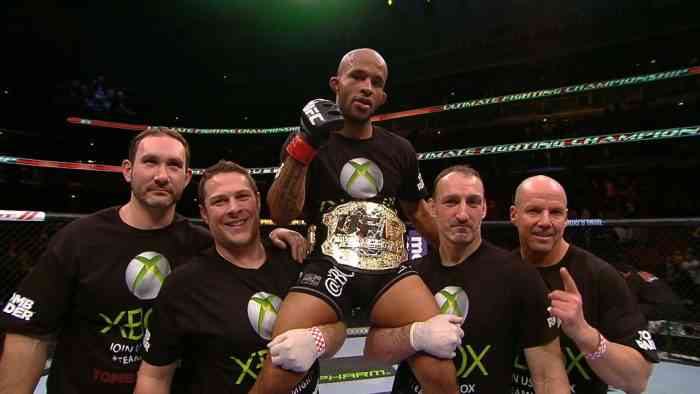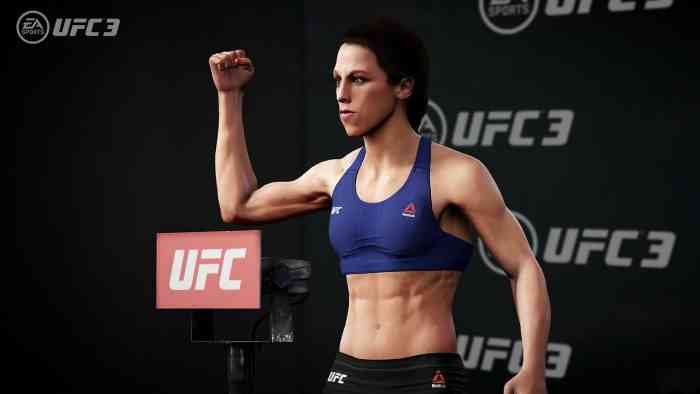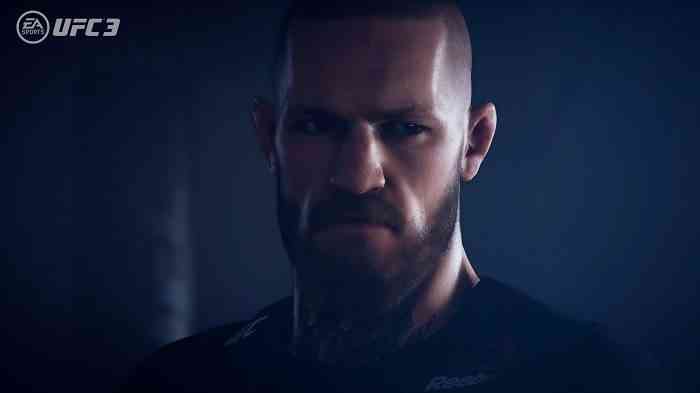EA Sports UFC 3 bringing the octagon back home in 2018…
It’s been a year and eight months since EA Sports UFC 2 arrived on consoles. Unlike most of EA’s other major sports titles, the UFC game hasn’t had to adhere to a yearly iteration cycle. The added development time has helped EA’s Vancouver studio refine EA Sports UFC 3 into so much more than just a roster update with a few small improvements. Instead, EA Sports UFC 3 got as drastic an overhaul as we’ve seen in a sports title, and could deliver one of the most authentic video game MMA experiences ever.
Ahead of the massive UFC 217 event, which features not one, not two, but three major title fights at Madison Square Garden, EA invited us out to go hands-on with an early build of EA Sports UFC 3. While the focus was primarily on getting in the octagon to test out UFC 3’s biggest new feature, Real Player Motion Tech, we learned a lot all the changes coming to next year’s sequel.
EA Sports UFC 3’s career mode will put the onus on you to become the greatest of all time. Using a series of challenges both in the octagon (most submission wins) and on the promotional side (career earnings milestones), UFC 3 will track your progress in truly becoming the GOAT in MMA. Unlike the previous entry, which was rather barebones, EA’s gone the extra mile this time, including new social media engagement (similar to Madden NFL), interspersed episodes of UFC Minute and Bad Blood to hype your fighter, and more cinematics building up your career and the universe of the UFC surrounding your fighter. It certainly seems like EA’s Vancouver studio has finally figured out how to make the virtual career more than just a grind of fights.
“To be fair, you always think you have it figured out until the game comes out and you learn maybe you didn’t quite have it figured out,” said creative director Brian Hayes. “We’ve made some huge improvements and major additions to career mode this year. In previous years, we relied on people to create goals for themselves. We wanted to put concrete clear objectives out there at every stage of your career whether you’re just starting out or whether it’s more long-term goals. That’s kind of the thread that will pull you through.”
______________________________
“EA Sports UFC 3 got as drastic an overhaul as we’ve seen in a sports title, and could deliver one of the most authentic video game MMA experiences ever.”
Camps will be back, though this time they too have been overhauled to give you more of a personal touch. Not only will you be able to visit 10 different gyms to train with UFC fighters, but you’ll also be able to learn new techniques from them as you progress. What’s more, sparring won’t just be a way for you to improve your stats in a given category. It’ll also help you actively gameplan as sparring partners will fight you with styles reminiscent of upcoming opponents. That’s right, no more generic combat in the lead-up to a heated contest with a rival. You’ll actually be able to work out a way to beat your next opponent.
There are a lot more elements to the career that EA will be sharing in the months leading up to February’s release of UFC 3, not to mention the streamlining of Ultimate Team and the addition of new couch play modes. Already it’s easy to see just how much the added development time has helped the studio craft a more complete game. Truthfully, even those upgrades pale in comparison to what Real Player Motion Tech brings to the table.

Real Player Motion Tech dramatically redefines everything about how EA Sports UFC 3 plays. In the last few EA UFC games, striking was accomplished by moving towards an opponent, jarringly coming to a halt, and then throwing punches and kicks. It was adequate enough for players to enjoy duking it out with the best MMA fighters in the world, but it always felt stilted no matter how great the body damage and reaction physics were at the time. Even actual UFC fighters, such as current Flyweight champion (and semi-pro gamer) Demetrious Johnson, felt EA Sports had a lot to improve upon.
“I’m always very critical of video games,” Johnson said. “The biggest thing I told them from UFC 2 to UFC 3 is every fighter has his own type of authenticity. They captured that in this one which is a huge, huge thing.”
He’s not wrong. It’s easy for a developer to tell you how much they’ve been able to improve the way a game plays, and it’s easy for them to show you in a video. While the early footage of in-octagon action in UFC 3 does look incredible, it’s not until you can actually step into the cage that you really see and feel the huge difference from the last entry.

More than 5,000 new animations have been captured from actual UFC fighters like Felice Herrig, Uriah Hall, Carla Esparza, and John Dodson, to name a few. Combined with the advances in motion capture, that means fighters act and react much more authentically than ever before. Previously, all fighter movement was built out of an algorithm combining fractions of the same movements together. That’s why so many fighters appeared to walk and pace around the octagon so similarly. Now, those new animations add wrinkles only specific fighters have, like Dominick Cruz’s elusive wriggling or Connor McGregor’s upright stalking.
All that added together means that not only can players more fluidly in a fight, but they can also move and strike at the same time. The days of stop and pop are over. Combos can be strung together while walking an opponent down against the cage wall. You can evade backwards while throwing out jabs to keep other fighters at bay. Like sharks, UFC fighters are always moving, and now that same feeling is brought to life in the game with spectacular realism.
“Based on the impact that the new Real Player Motion Tech has had on the game overall, it’s the most important thing we’ve done this year. Easily,” Hayes said. “What’s it’s done to transform the stand-up experience, what it’s done to transform our motion capture of UFC athletes, what it’s done to make the athletes look way more accurate in-game, the benefits are almost innumerable.”

We played a handful of bouts all based on the championship fights happening at UFC 217 and came away immediately impressed with the stand-up game improvements. Notably, the speed and weight of the different classes was prevalent as soon as the fights began. While earlier EA Sports UFC games had a definite speed difference in fighters, there wasn’t as much of a variation in the feel of heft between the weight classes. Now when you play as Strawweights like Joanna Jędrzejczyk and Rose Namajunas, then move up to Michael Bisping and Georges St-Pierre, there’s an undeniable variance in how they feel to move and control in the octagon.
It’s incredibly satisfying to move and strike as someone like Strawweight champion Joanna Jędrzejczyk too, as her whole game is about continuing the pressure. UFC 3 finally lets you feel like you are actively controlling a fight by pressing any advantage you may have since you can step and strike, versus before where you had to choose between stepping or striking. Considering 85% of the fights in EA Sports UFC 2 stayed standing, the improvements this overhaul brought about cannot be overstated.
______________________________
“Unfortunately for newcomers, the ground game still has a heavy learning curve and doesn’t quite have the same satisfying feel as the stand-up.”
“Your average UFC does probably enjoy a Justin Gaethje/Michael Johnson affair more so than they enjoy Gunnar Nelson/Damian Maia,” Hayes added. “To be clear, Nelson/Maia was an amazing technical grappling spectacle, but on average it’s the more nuanced UFC fan that has a little bit more appreciation for what goes on there. It’s not all that surprising to see that reflected in the gameplay data, where people like to stand and bang.”
Unfortunately for newcomers, the ground game still has a heavy learning curve and doesn’t quite have the same satisfying feel as the stand-up. As one of the most complex sports to be translated into a video game, it’s not always easy to convey all the nuance of the grappling in a virtual experience. New tutorials, both in-game and in practice modes, certainly help, but when you’re just thrown into the octagon for a brief gameplay demonstration, the ground game is a bit baffling.
“We do realize that it was a challenge for people that wanted to learn and be more competitive,” Hayes explained. “That’s what we’re trying to do for them by making better in-game tutorials, better community video tutorials, so that the information is there. If you want to learn the nuances in these different positions, the information is there for you and accessible so you won’t be as lost.”

For all the improvements the motion capture technology added to fighters’ upright combat, the subtleties of submissions and transition control aren’t quite as easy to observe. That’s mostly because you spend more time on the ground trying to read the various meters and directions on what to do next versus enjoying the battle for dominance. The dynamism of elite fighters on the ground gets lost in translation, but something has to give in order to gamify the more technical aspects of MMA.
“I think the movement on the feet is captured a lot better in UFC 3,” Johnson said. “With the grappling game, that’s one of the things where the game slows down a bit. You can’t have that scrambling ability because if you have that, everybody just gets to their feet. At the end of the day, it’s a game, and I think they have been the best at capturing a simulated fight.”
After going 20 or so rounds with EA Sports UFC 3, we have to agree with Demetrious Johnson. The development team has always faced an uphill battle with the complexity of the sport being translated to about a dozen different buttons, but EA Sports UFC 3 certainly appears to have done it better than any other iteration in the past. There are still some months to come until we’ll be able to dive deeply into everything that makes EA Sports UFC 3 tick, but from what we saw this week there’s a lot to be excited about for the February release.

